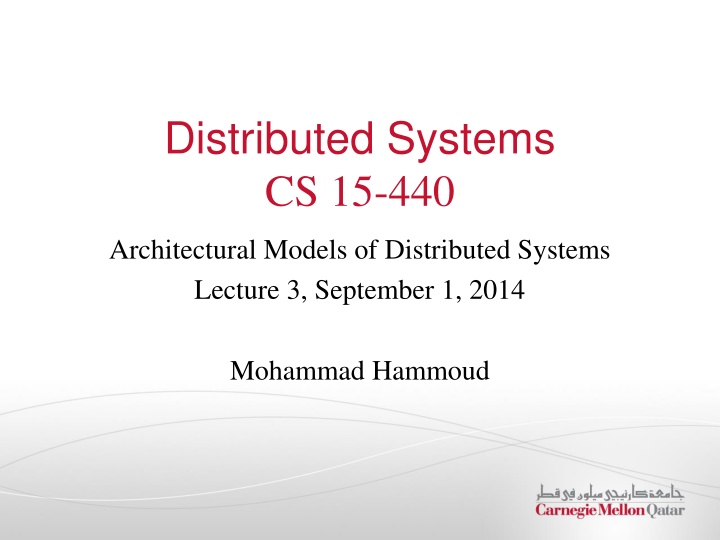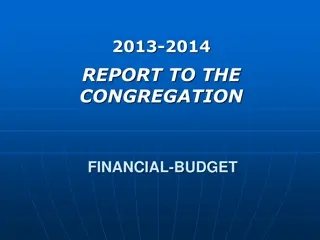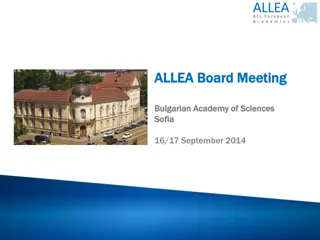
Architectural Models of Distributed Systems: Overview and Classification
Explore the architectural models and classification of distributed systems, including communicating entities, communication paradigms, and physical infrastructure mapping. Understand the entities involved, their communication methods, roles, responsibilities, and placement within distributed systems. Dive into the trends, challenges, and key components of these complex systems.
Download Presentation

Please find below an Image/Link to download the presentation.
The content on the website is provided AS IS for your information and personal use only. It may not be sold, licensed, or shared on other websites without obtaining consent from the author. If you encounter any issues during the download, it is possible that the publisher has removed the file from their server.
You are allowed to download the files provided on this website for personal or commercial use, subject to the condition that they are used lawfully. All files are the property of their respective owners.
The content on the website is provided AS IS for your information and personal use only. It may not be sold, licensed, or shared on other websites without obtaining consent from the author.
E N D
Presentation Transcript
Distributed Systems CS 15-440 Architectural Models of Distributed Systems Lecture 3, September 1, 2014 Mohammad Hammoud
Today Last Session: Trends and challenges in Distributed Systems Today s Session: Architectural Models of Distributed Systems Announcements: Project 1 will be posted by tonight. Design report is due on Saturday Sep. 13 at 11:59PM. Project is due on Oct 1 at 11:59pm. PS1 is due on Monday Sep. 8 at 11:59PM
A Distributed System A distributed system is simply a collection of hardware/software components that communicate to solve a complex problem Each component performs a task Components performing tasks C0 C1 Communication mechanism C2
Birds Eye View of Some Distributed Systems Peer 2 Google Server Expedia Peer 1 Peer 3 Search Client 1 Search Client 2 Search Client 3 Reservation Client 1 Reservation Client 2 Reservation Client 3 Peer 4 Bit-torrent Skype Google Search Airline Booking How would one classify these distributed systems?
Classification of Distributed Systems What are the entities that are communicating in a DS? a) Communicating entities How do the entities communicate? b) Communication paradigms What roles and responsibilities do they have? c) Roles and responsibilities How are they mapped to the physical distributed infrastructure? d) Placement of entities
Classification of Distributed Systems What are the entities that are communicating in a DS? a) Communicating entities How do the entities communicate? b) Communication paradigms What roles and responsibilities do they have? c) Roles and responsibilities How are they mapped to the physical distributed infrastructure? d) Placement of entities
Communicating Entities What entities are communicating in a DS? System-oriented entities Processes Threads Nodes Problem-oriented entities Objects (in object-oriented programming based approaches)
Classification of Distributed Systems What are the entities that are communicating in a DS? a) Communicating entities How do the entities communicate? b) Communication paradigms What roles and responsibilities do they have? c) Roles and responsibilities How are they mapped to the physical distributed infrastructure? d) Placement of entities
Communication Paradigms Three types of communication paradigms Inter-Process Communication (IPC) Remote Invocation Indirect Communication Applications, Services Remote Invocation, Indirect Communication Middleware layers IPC Primitives Internet Protocols
Inter-Process Communication (IPC) Relatively low-level support for communication e.g., Direct access to internet protocols (Socket API) Advantages Enables seamless communication between processes on heterogeneous operating systems Well-known and tested API adopted across multiple operating systems Disadvantages Increased programming effort for application developers Socket programming: Programmer has to explicitly write code for communication (in addition to program logic) Space Coupling (Identity is known in advance): Sender should know receiver s ID (e.g., IP Address, port) Time Coupling: Receiver should be explicitly listening to the communication from the sender
Remote Invocation An entity runs a procedure that typically executes on an another computer without the programmer explicitly coding the details for this remote interaction A middleware layer will take care of the raw-communication Examples Remote Procedure Call (RPC) Sun s RPC (ONC RPC) Remote Method Invocation (RMI) Java RMI
Remote Invocation Advantages: Programmer does not have to write code for socket communication Disadvantages: Space Coupling: Where the procedure resides should be known in advance Time Coupling: On the receiver, a process should be explicitly waiting to accept requests for procedure calls
Space and Time Coupling in RPC and RMI The sender knows the Identity of the receiver (space coupling) Time Coupling Request Message doOperation . . (wait) . . (continuation) getRequest . Select operation . Execute operation . Send reply Reply Message Sender Receiver RMI strongly resembles RPC but in a world of distributed objects
Indirect Communication Paradigm Indirect communication uses middleware to: Provide one-to-many communication Some mechanisms eliminate space and time coupling Sender and receiver do not need to know each other s identities Sender and receiver need not be explicitly listening to communicate Approach used: Indirection Sender A middle-man Receiver Types of indirect communication 1. Group communication 2. Publish-subscribe 3. Message queues
1. Group Communication One-to-many communication Multicast communication Sender Abstraction of a group Group is represented in the system by a groupId Recipients join the group A sender sends a message to the group which is received by all the recipients Recv 2 Recv 1 Recv 3
1. Group Communication (contd) Services provided by middleware Group membership Handling the failure of one or more group members Advantages Enables one-to-many communication Efficient use of bandwidth Identity of the group members need not be available at all nodes Disadvantages Time coupling
2. Publish-Subscribe An event-based communication mechanism Publishers publish events to an event service Subscribers express interest in particular events Subscribers Publishers Subscribe (Event3) Publish-subscribe Event Service Publish (Event2) Large number of producers distribute information to large number of consumers
2. Publish-Subscribe (contd) Example: Financial trading External source Dealer scomputer Notification Dealer process Information providers
3. Message Queues A refinement of Publish-Subscribe where Producers deposit the messages in a queue Messages are delivered to consumers through different methods Queue takes care of ensuring message delivery Advantages Enables space decoupling Enables time decoupling
Recap: Communication Entities and Paradigms Communicating entities (what is communicating) Communication Paradigms (how they communicate) System- oriented Problem- oriented IPC Remote Invocation Indirect Communication Nodes Processes Threads Objects Sockets RPC RMI Group communication Publish-subscribe Message queues
Classification of Distributed Systems What are the entities that are communicating in a DS? a) Communicating entities How do the entities communicate? b) Communication paradigms What roles and responsibilities do they have? c) Roles and responsibilities How are they mapped to the physical distributed infrastructure? d) Placement of entities
Roles and Responsibilities In DS, communicating entities take on roles to perform tasks Roles are fundamental in establishing overall architecture Question: Does your smart-phone perform the same role as Google Search Server? We classify DS architectures into two types based on the roles and responsibilities of the entities Client-Server Peer-to-Peer
Client-Server Architecture Approach: Server provides a service that is needed by a client Client requests to a server (invocation), the server serves (result) Widely used in many systems e.g., DNS, Web-servers Invocation Result Client Server Client
Client-Server Architecture: Pros and Cons Advantages: Simplicity and centralized control Computation-heavy processing can be offloaded to a powerful server Clients can be thin Disadvantages Single-point of failure at server Scalability
Peer to Peer (P2P) Architecture In P2P, roles of all entities are identical All nodes are peers Peers are equally privileged participants in the application e.g.: Napster, Bit-torrent, Skype
Peer to Peer Architecture Example: Downloading files from bit-torrent Peer 1 wants a file. Parts of the file is present at peers 3,4 and 5 Peer 3 wants a file stored at peers 1,2 and 6 Peer 2 Peer 1 Peer 3 Peer 6 Peer 4 Peer 5
Architectural Patterns Primitive architectural elements can be combined to form various patterns Tiered Architecture Layering Tiered architecture and layering are complementary Layering = vertical organization of services Tiered Architecture = horizontal splitting of services
Tiered Architecture A technique to: 1. Organize the functionality of a service, and 2. Place the functionality into appropriate servers Airline Search Application Get data from database Display UI screen Get user Input Rank the offers
A Two-Tiered Architecture How do you design an airline search application: EXPEDIA Airline Search Application Display user input screen Get user Input Airline Database Display result to user Rank the offers Tier 1 Tier 2
A Three-Tiered Architecture How do you design an airline search application: EXPEDIA Airline Search Application Display user input screen Get user Input Airline Database Display result to user Rank the offers Tier 1 Tier 2 Tier 3
A Three-Tiered Architecture Application Logic Data Logic Presentation Logic User view, and controls Application- Specific Processing Database manager User view, and control Application- Specific Processing Tier 3 Tier 2 Tier 1
Three-Tiered Architecture: Pros and Cons Advantages: Enhanced maintainability of the software (one-to-one mapping from logical elements to physical servers) Each tier has a well-defined role Disadvantages Added complexity due to managing multiple servers Added network traffic Added latency
Layering A complex system is partitioned into layers Upper layer utilizes the services of the lower layer A vertical organization of services Layering simplifies design of complex distributed systems by hiding the complexity of below layers Control flows from layer to layer Layer 3 Response flow Request flow Layer 2 Layer 1
Layering Platform and middleware Distributed Systems can be organized into three layers 1. Platform Low-level hardware and software layers Provides common services for higher layers 2. Middleware Mask heterogeneity and provide convenient programming models to application programmers Typically, it simplifies application programming by abstracting communication mechanisms Applications 3. Applications Middleware Operating system Platform Computer and network hardware
Classification of Distributed Systems What are the entities that are communicating in a DS? a) Communicating entities How do the entities communicate? b) Communication paradigms What roles and responsibilities do they have? c) Roles and responsibilities How are they mapped to the physical distributed infrastructure? d) Placement of entities
Placement Observation: A large number of heterogonous hardware (machines, networks) Smart mapping of entities (processes, objects) to hardware helps performance, security and fault-tolerance Placement maps entities to underlying physical distributed infrastructure Placement should be decided after a careful study of application characteristics Example strategies: Mapping services to multiple servers Moving the mobile code to the client
Placement User- interface Entities Web search indexing Mobile Code Physical infrastructure Hi-performance Server Desktop Smart-phone
Recap We have covered primitive architectural elements Communicating entities Communication paradigms of entities IPC, RMI, RPC, Indirect Communication Roles and responsibilities that entities assume, and resulting architectures Client-Server, Peer-to-Peer, Hybrid Placement of entities
Next Class Identify different types of networks Describe networking principles such as layering, encapsulation and packet-switching Examine how packets are routed and how congestion is avoided Analyze scalability, reliability and fault-tolerance of Internet















